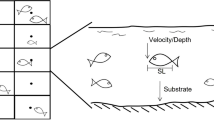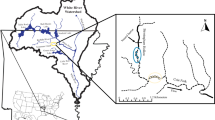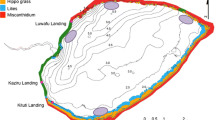Abstract
In the headwaters of the New River in western North Carolina, the dominant crayfish species changes with increasing stream size. One transition occurs between third- and fourth-order streams. Cambarus chasmodactylus is the dominant species in third-order tributaries. Orconectes cristavarius is the dominant species in the fourth-order South Fork of the New River. While adult C. chasmodactylus are present in the South Fork, the young-of-the-year (YOY) of this species are absent despite evidence of reproduction. In this study we evaluated the factors that may be responsible for the absence of C. chasmodactylus YOY from the South Fork. A field experiment was used to evaluate the role of abiotic factors and competition with YOY O. cristavarius. There was no significant effect of either of these factors on mortality or growth of C. chasmodactylus YOY. The growth rate of O. cristavarius was 3× faster than that of C. chasmodactylus in this experiment. Since neither abiotic factors nor competition appeared responsible for the exclusion of C. chasmodactylus YOY from the South Fork we evaluated the potential importance of selective predation by rock bass (Ambloplites rupestris), a fish species that is common in the South Fork but virtually absent in the tributaries. In a laboratory experiment, C. chasmodactylus YOY experienced significantly higher mortality than O. cristavarius YOY in the presence of rock bass. Field observations and a laboratory experiment suggest that the two crayfish species differ in their anti-predator behaviors. Cambarus chasmodactylus was less likely to swim when initially disturbed and swam shorter distances than O. cristavarius. The differences in escape behavior and growth rate may contribute to the differences in the vulnerability of the two species to rock bass predation. Our results suggest that intense predation pressure exerted by the rock bass may contribute to the virtual exclusion of C. chasmodactylus YOY from the fourth-order South Fork.



Similar content being viewed by others
References
Angermeier, P. L., 1992. Predation by rock bass on other stream fishes: experimental effects of depth and cover. Environmental Biology of Fishes 34: 171–180.
Blank G. S. & M. H. Figler, 1996. Interspecific shelter competition between the sympatric crayfish Procambarus clarkia (Girard) and Procambarus zonangulus (Hobbes and Hobbs). Journal of Crustacean Biology 16: 300–309.
Bovbjerg, R. V., 1970. Ecological isolation and competitive exclusion in two crayfish (Orconectes virilis and Orconectes immunis). Ecology 51: 225–236.
Brown, B. L., 1999. Ecological interactions of the branchiobdellid Cambarincola with the host crayfish Cambarus chasmodactylus and Orconectes cristavarius. Masters Thesis, Appalachian State University, Boone, NC.
Chesson, J., 1983. The estimation and analysis of preference and its relation to foraging models. Ecology 64: 1297–1304.
Connell, J. H., 1961. The influence of interspecific competition and other factors on the distribution of the barnacle Chthamalus stellatus. Ecology, 42: 710–723.
Creed, R. P., 1990. The direct and indirect effects of omnivorous crayfish on stream benthic communities. PhD Thesis, Michigan State University, East Lansing, MI.
Creed, R. P., 1994. Direct and indirect effects of crayfish grazing in a stream community. Ecology 75: 2091–2103.
Creed, R. P., 2006. Predator transitions in stream communities: a model and evidence from field studies. Journal of the North American Benthological Society 25: 533–544.
Creed, R. P. & J. M. Reed, 2004. Ecosystem engineering by crayfish in a headwater stream community. Journal of the North American Benthological Society 23: 224–236.
Crowl, T. A., C. R. Townsend & A. R. McIntosh, 1992. The impact of introduced brown and rainbow trout on native fish: the case of Australasia. Reviews in Fish Biology and Fisheries 2: 217–241.
Dorn, N. J. & G. G. Mittelbach, 1999. More than predator and prey: a review of interactions between fish and crayfish. Vie et Milieu 49: 229–237.
Englund, G., 1999. Effects of fish on the local abundance of crayfish in stream pools. Oikos 87: 48–56.
Englund, G. & J. J. Krupa, 2000. Habitat use by crayfish in stream pools: influence of predators, depth and body size. Freshwater Biology 43: 75–83.
Feminella, J. W. & C. P. Hawkins, 1994. Tailed frog tadpoles differentially alter their feeding behavior in response to non-visual cues from four predators. Journal of the North American Benthological Society 13: 310–320.
Flinders, C. A. & D. D. Magoulick, 2003. Effects of stream permanence on crayfish community structure. American Midland Naturalist 149: 134–147.
Flynn, M. E. & H. H. Hobbs, 1984. Parapatric crayfishes in southern Ohio: evidence of competitive exclusion? Journal of Crustacean Biology 4: 382–389.
Fortino, K., 2000. Does a predator transition determine the distribution of crayfish in the New River, N. C.? Masters Thesis, Appalachian State University, Boone, NC.
Fraser, D. F., J. F. Gilliam & T. Yip-Hoi, 1995. Predation as an agent of population fragmentation in a tropical watershed. Ecology 76: 1461–1472 .
Garvey, J. E., R. A. Stein & H. M. Thomas, 1994. Assessing how fish predation and interspecific prey competition influence a crayfish assemblage. Ecology 75: 532–547.
Gherardi, F. & W. H. Daniels, 2004. Agonism and shelter competition between invasive and indigenous crayfish species. Canadian Journal of Zoology 82: 1923–1932.
Gilliam, J. F., D. F. Fraser & M. Alkins-Koo, 1993. Structure of a tropical stream community: a role for biotic interactions. Ecology 74: 1856–1870.
Goldberg, D. E. & P. A. Werner, 1983. Equivalence of competitors in plant communities: a null hypothesis and field experimental approach. American Journal of Botany 70: 1098–1104.
Griffith, M. B., S. A. Perry & W. B. Perry, 1994. Secondary production of macroinvertebrate shredders in headwater streams with different baseflow alkalinity. Journal of the North American Benthological Society 13: 345–356.
Hawkins, C. P., L. J. Gottschalk & S. S. Brown, 1988. Densities and habitat of tailed frog tadpoles in small streams near Mt. St. Helens following the 1980 eruption. Journal of the North American Benthological Society 7: 246–252.
Helms, B. S. & R. P. Creed, 2005. The effects of 2 coexisting crayfish on an Appalachian river community. Journal of the North American Benthological Society 24: 113–122.
Huryn, A. D. & J. B. Wallace, 1987. Production and litter processing by crayfish in an Appalachian mountain stream. Freshwater Biology 18: 277–286.
Kohler, S. L., 1992. Competition and the structure of a benthic stream community. Ecological Monographs 62: 165–188.
Manly, B. F. J., 1974. A model for certain types of selection experiments. Biometrics 30: 281–294.
Mather, M. E. & R. A. Stein, 1993. Direct and indirect effects of fish predation on the replacement of native crayfish by an invading congener. Canadian Journal of Fisheries and Aquatic Science 50: 1297–1288.
McPeek, M. A., 1990a. Determination of species composition in the Enallagma damselfly assemblages of permanent lakes. Ecology 71: 83–98.
McPeek, M. A., 1990b. Behavioral differences between Enallagma species (Odonata) influencing differential vulnerability to predators. Ecology 71: 1714–1726 .
Menge, B. A. & G. M. Branch, 2001. Rocky intertidal communities. In: Bertness M. D., S. D. Gaines & M. E. Hay (eds), Marine Community Ecology. Sinauer Associates, Sunderland, MA, USA: 221–251.
Menge, B. A. & J. P. Sutherland, 1987. Community regulation: variation in disturbance, competition, and predation in relation to environmental stress and recruitment. American Naturalist 130: 730–737.
Mittelbach, G. G., 1988. Competition among refuging sunfishes and effects of fish density on littoral zone invertebrates. Ecology 69: 614–623.
Parkyn, S. M., C. F. Rabeni & K. J. Collier, 1997. Effects of crayfish (Paranephrops planifrons: Parastacidae) on in-stream processes and benthic faunas: a density manipulation experiment. New Zealand Journal of Marine and Freshwater Research 31: 685–692.
Paterson, G., K. G. Drouillared & G. D. Haffner, 2005. Quantifying resource partitioning in centrarchids with stable isotope analysis. Limnology and Oceanography 51: 1038–1044.
Peckarsky, B. L., 1983. Biotic interactions or abiotic limitations? A model of lotic community structure. In: Fontaine T. D. III & S. M. Bartell (eds), Dynamics of Lotic Ecosystems. Ann Arbor Science Publishers, Ann Arbor, MI, USA: 303–323.
Poff, N. L. & J. V. Ward, 1989. Implications of streamflow variability and predictability for lotic community structure: a regional analysis of streamflow patterns. Canadian Journal of Fisheries and Aquatic Science 46: 1805–1817.
Probst, W. E., C. F. Rabeni, W. G. Covington & R. E. Marteney, 1984. Resource use by stream-dwelling rock bass and smallmouth bass. Transactions of the American Fisheries Society 113: 283–294.
Rabeni, C. F., 1985. Resource partitioning by stream-dwelling crayfish: the influence of body size. American Midland Naturalist 113: 20–29.
Rabeni, C. F., 1992. Trophic linkage between stream centrarchids and their crayfish prey. Canadian Journal of Fisheries and Aquatic Sciences 49: 1714–1721.
Rhoades, R., 1962. Further studies on Ohio crayfishes: cases of sympatry of stream species in southern Ohio. Ohio Journal of Science 62: 27–33.
Richardson, F. R. & W. C. Carnes, 1964. Survey and classification of the New River and tributaries, North Carolina. Final Report, Project F-14-R, North Carolina Wildlife Resources Commission, Raleigh, NC.
Roell, M. J. & D. J. Orth, 1993. Trophic basis of production of stream-dwelling smallmouth bass, rock bass, and flathead catfish in relation to invertebrate bait harvest. Transactions of the American Fisheries Society 122: 46–62.
Seiler, S. M. & A. M. Turner, 2004. Growth and population size of crayfish in headwater streams: individual- and higher-level consequences of acidification. Freshwater Biology 49: 870–881.
Sih, A., L. B. Kats & R. D. Moore, 1992. Effects of predatory sunfish on the density, drift, and refuge use of stream salamander larvae. Ecology 73: 1418–1430.
Skelly, D. K., 1995. A behavioral trade-off and its consequences for the distribution of Pseudacris treefrog larvae. Ecology 76: 150–164.
Sousa, W. P., 1984. The role of disturbance in natural communities. Annual Review of Ecology and Systematics 15: 353–391.
Storfer, A. & A. Sih, 1998. Gene flow and ineffective anti-predator behavior in a stream-breeding salamander. Evolution 52: 558–565.
Townsend, C. R. & T. A. Crowl, 1991. Fragmented population structure in a native New Zealand fish: an effect of introduced brown trout? Oikos 61: 347–354.
Trexler, J. C. & J. Travis, 1993. Nontraditional regression analyses. Ecology 74: 1629–1637.
Usio, N., 2000. Effects of crayfish on leaf processing and invertebrate colonisation of leaves in a headwater stream: decoupling of a trophic cascade. Oecologia (Berlin) 124: 608–614.
Usio, N. & C. R. Townsend, 2000. Distribution of the New Zealand crayfish Paranephrops zealandicus in relation to stream physico-chemistry, predatory fish, and invertebrate prey. New Zealand Journal of Marine and Freshwater Research 34: 557–567.
Van Deventer, J. S. & W. S. Platts, 1983. Sampling and estimating fish populations from streams. Transactions of the North American Wildlife and Natural Resources Conference 48: 349–354.
Van Deventer, J. S. & W. S. Platts. 1989. Microcomputer software system for generating population statistics from electrofishing data-user’s guide for MicroFish 3.0. U. S. Forest Service General Technical Report INT-254.
Vannote, R. L., G. W. Minshall, K. W. Cummins, J. R. Sedell & C. E. Cushing, 1980. The river continuum concept. Canadian Journal of Fisheries and Aquatic Science 37: 130–137.
Wellborn, G. A., D. K. Skelly & E. E. Werner, 1996. Mechanisms creating community structure across a freshwater habitat gradient. Annual Review of Ecology and Systematics 27: 337–363.
Woodward, B. D., 1983. Predator-prey interactions and breeding-pond use of temporary-pond species in a desert anuran community. Ecology 64: 1549–1555.
Acknowledgements
This research was supported by grants from the Theodore Roosevelt fund of the American Museum of Natural History and the Graduate School at Appalachian State University. We would like to thank Brian Helms, Bryan Brown, Nate Bickford, Todd Ewing, Beth Hudson, Claire Bird, Ben Hooker, Travis Howe, Karen Geissenger, Lee Echols and Kristen Helms for their ideas and assistance. We are indebted to Todd Ewing, Kin Hodges, Tim Lemon, Shay Dumas, and a number of Appalachian State University students for their assistance with the electroshocking. We would like to thank Matt Rowe and Ray Williams for their comments and suggestions throughout this project. Jim Gilliam, Steve Kohler, Andy Sheldon, Alexia Kelley, and two anonymous reviewers provided valuable comments on an earlier version of this manuscript.
Author information
Authors and Affiliations
Corresponding author
Additional information
Handling editor: J. Trexler
Rights and permissions
About this article
Cite this article
Fortino, K., Creed, R.P. Abiotic factors, competition or predation: what determines the distribution of young crayfish in a watershed?. Hydrobiologia 575, 301–314 (2007). https://doi.org/10.1007/s10750-006-0378-7
Received:
Revised:
Accepted:
Published:
Issue Date:
DOI: https://doi.org/10.1007/s10750-006-0378-7




